Natural Selection and Speciation
2-D says, “We Monarchs don’t worry about hiding like the
moths described below. We taste
so bad that, instead, we advertize that with our bright orange and black
color pattern. That way, would-be predators know to leave us alone. We have
our share of natural selection, though, like the problems with deforestation
in the areas of Mexico where we spend the winter.”
English Peppered Moths (Biston betularia)

Peppered Moths on Tree Trunks
One of the best documented examples of natural selection in modern times is
the English Peppered Moth (Biston betularia). Typically, this moth
is whitish with black speckles and spots all over its wings. During the
daytime, Peppered moths are well-camouflaged as they rest on the speckled
lichens on tree trunks. Occasionally a very few moths have a genetic
mutation which causes them to be all black, so they are said to be
melanistic.
Black moths resting on light-colored, speckled lichens are not very well
camouflaged, and so are easy prey for any moth-eating birds that happen by.
Thus, these melanistic moths never get to reproduce and pass on their genes
for black color. However, an interesting thing happened to these moths in
the 1800s. With the Industrial Revolution, many factories and homes in
British cities started burning coal, both for heat and to power all those
newly-invented machines. Coal does not burn cleanly, and creates a lot of
black soot and pollution. Since lichens are extremely sensitive to air
pollution, this caused all the lichens on city trees to die. Also, as the
soot settled out everywhere, this turned the city tree trunks (and everything
else) black. This enabled the occasional black moths living in the cities to
be well-camouflaged so they could live long enough to reproduce, while the
“normal” speckled moths were gobbled up. Studies done in the earlier 1900s
showed that while in the country, the speckled moths were still the
predominant form, in the cities, they were almost non-existant. Nearly all
the moths in the cities were the black form. It was evident to the
researchers, notably Henry Bernard Davis (H. B. D.) Kettlewell (famous for
his research on industrial melanism in Peppered Moths), studying
these moths that the black city moths were breeding
primarily with other black city moths while speckled country moths were
breeding primarily with other speckled country moths. Because of this, any
new genetic mutations in one or the other of those populations would only be
passed on within that population and not throughout the whole moth population.
Additionally, because the city and country environments were different, there
were different selective pressures on city vs. country moths that could
potentially drive the evolution of these two populations of moths in
different directions. The researchers pointed out that if this were to
continue for a long enough time, the city and country moths could become so
genetically different that they could no longer interbreed with each other,
and thus would be considered distinct species. In this case, what actually
happened is that the people of England decided they didn’t like breathing
and living in all that coal pollution, thus found ways to clean things up.
As the air became cleaner, lichens started growing on city trees again, thus
the direction of the selective pressure (birds) was once again in favor of
the speckled moths. By now, English cities, as well as countrysides, both
have a mixture of speckled and black moths, and all are interbreeding at
random, thus were not separated for long enough to develop into separate
species.
While this has long been the accepted explanation for what’s
going on,
an
article in the 24 May 1999 issue of The Scientist
13(11) presents and discusses data which may refute this long-held
idea. (Nov 2015: Link no longer works — try the library)
Artificial and Natural Selection:
As another example, back in 1951, a biopsy of cervical cancer
was removed from a woman named Henrietta Lacks and grown in tissue culture.
While Ms. Lacks died later in 1951, HeLa cells are a widely-cultured
research “organism” available through a number of biological supply
companies.
(See the Lecture 1 Mitosis Page,
about half-way down, in the “Tissue Culture and Cancer” section, for more
information about Ms. Lacks.)
Somewhat recently, an interesting issue has arisen regarding
these cells: are they still “human?” While HeLa cells currently being grown
in tissue culture are descendents of the original human cancer cells
(so not “normal” human to begin with), by now they have mutated so much due
to artificial selection as well as natural selection, and
there are so many different strains (genetic varieties) that some
researchers have raised the question whether they can still be considered
“human” tissue.

Interactions Involved in Natural Selection
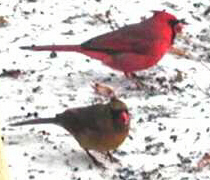
Male and Female Cardinals (©DBF)
One important thing thing to note here is that populations, not
individuals, evolve: individuals can have genetic mutations (can change),
but unless those mutations are passed along to offspring and thus into the
gene pool of the population, no real change has occurred. An
individual who has a mutation but does not pass it on (for whatever reason)
has no long term effect on the genes present in the population as a whole.
Another important point is that natural selection operates on the
genetics of a species, including whatever genes affect instinctive
behavior patterns as well as those affecting the looks of the individuals.
Thus, genetics, looks, behavior, and external environmental factors are all
interwoven. Sometimes, there are tradeoffs between various genes and
selective pressures. For example, the bright red color of a male Cardinal
might be very attractive to a female, such that the brighter a male is, the
greater his chances of mating, but that same bright red color, especially
against a snowy background, makes him much more visible to predators.
The Role of Population Genetics:
Another factor relating to populations as the unit of
evolution is that the various alleles for a species’ genes are not equally
present in all populations. For any given gene, the number or percentage of
each allele in the population can be calculated, and varies among different
populations of organisms. This is different from the genetics and Punnett
squares we studied last quarter! You may recall from last quarter that
“bad” genetic mutations like sickle-cell, cystic fibrosis, Tay Sachs, etc.
are more prevalent in certain ethnic groups. As another example, you may
recall last quarter’s discussion of PTC (phenylthiocarbamide) paper. People
with the dominant allele for the tasting gene (TT or Tt) are able to taste
this substance, and react negatively to its bitter taste, while people with
the recessive allele (tt) find this substance to be tasteless (and hopefully
you still remember how to do a Punnett square for any two given individuals?).
However, for the general population of North America, about 70% of the
population are tasters, while about 30% are non-tasters. From this, someone
who studies population genetics, could calculate that therefore, in a
group of 100 people (thus 200 alleles — remember?), there would be 110
t alleles (from Tt and tt people) and 90 T alleles (from TT and
Tt people),
so 20 people would be TT, 50 people would be Tt, and 30 people
would be tt. As another example, those of you who had lab last
quarter may recall from the blood-typing handout that about 45% of the average
population of the U. S. is type O, 42% type A, 10% type B, and 3% type AB.
However, these percentages are not the same for all populations. For
example:
| Ethnic Group |
Percentage of the People |
| Type O |
Type A |
Type B |
Type AB |
Australian
Aborigines |
42.6 |
57.4 |
0.0 |
0.0 |
| Berliners |
36.5 |
42.5 |
14.5 |
6.5 |
Peking
Chinese |
30.7 |
25.1 |
34.2 |
10.0 |
Native American
(Blackfeet) |
23.5 |
76.5 |
0.0 |
0.0 |
Native American
(Panamanians) |
100.0 |
0.0 |
0.0 |
0.0 |
Native American
(Utes) |
97.4 |
2.6 |
0.0 |
0.0 |
| Siberian Buriats |
32.4 |
20.2 |
39.2 |
8.2 |
Zairian
Pygmies |
30.6 |
30.3 |
29.1 |
10.0 |
There are a number of factors that can influence the
percentage of the alleles in a given population, and random change in the
genetic make-up of a population can be due to a number of factors:
- mutations in some individuals,
- random events that suddenly kill off all but a few of the population,
referred to as the bottleneck effect (The effects of this decrease in
the variation in the gene pool are especially noticeable in endangered
species with low numbers of individuals to begin with. For example,
cheetahs all have nearly identical alleles for almost all of their genes.
This makes the population more susceptible to extinction if there is a
sudden environmental change with which that genotype cannot cope.
Conversely, if there is more variation in genotypes, there is a greater
chance that at least some individuals will be able to survive “unusual”
conditions.),
- immigration (to come into an area) and emigration (to leave
an area) (im = in; e-; migratus = to move = out), the
movement of individuals with different allelic make-ups into or out of the
population under study,
and/or
- non-random mating (the mathematical model used to calculate the frequencies
of the alleles assumes that mating is random — that any individual in the
population is equally likely to mate with any individual of the opposite sex.
Frequently, mating is non-random, like in humans where a person is most
likely to marry within the same race or ethnic group.).
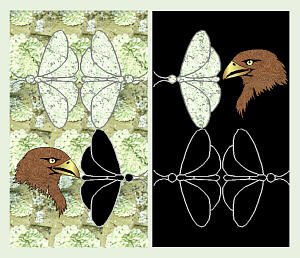
Natural Selection in Action
All of these genes/alleles are subjected to natural selection. Some of the
alleles code for certain body features or behaviors which are better suited
to the environment than others. Organisms with those alleles are more likely
to reproduce and pass on those alleles. Other alleles are not as well suited,
and an organism with that genotype dies or is not able to reproduce, so the
alleles never get passed on. Over time, this leads to speciation,
the division of one species into two or more species. By definition, a
species is a reproductively-isolated population of organisms.
In other words, members can interbreed with each other, but not with
non-members of that species.
The Role of Continental Drift:
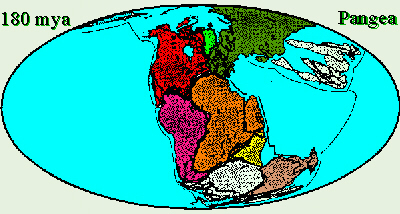
Pangea, 180 mya

Cycad, a Pine Relative Similar to Those on Pangea
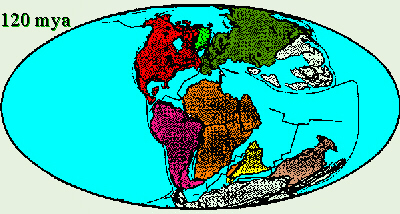
Pangea Breaking Up, 120 mya
While all this has been occurring, another influencing factor
has been the fact that the continents have been moving at a rate of about
5 to 10 cm or so per year. The movement of the continents is called
continental drift, and the study of this movement is called
plate tectonics.
About 200 to 180 million years ago (mya), all of the continents were united
in one large land mass called
Pangea,
thus the ocean was one big ocean called
Panthalassa.
This, along with the ubiquitous tropical climate, was significant because any
animals that were present then could spread everywhere. This time period has
been called the “age of dinosaurs” because of their prevalence (same for
insects). There were also large fern-type plants, conifers (relatives of
pine trees), and various insects like roaches. Around this time, the first
mammals, the
marsupials
came into existance, and began to spread everywhere. By about 130 to 120 mya,
Pangea broke into two land masses. Laurasia was the northern
continent (consisting of current North America, Europe, and Asia), and
Gondwana was the southern land mass (consisting of South America,
Africa, India, Australia, and Antarctica). Before this split,
marsupial-type mammals had spread everywhere, but around the time the
continents were drifting apart, the
placental mammals
evolved in Laurasia, and began to spread, outcompeting the marsupials
wherever they became established. Everywhere the placental mammals became
established, nearly all of the marsupials died off. For example, here in
North America, the opposum is the only marsupial mammal left, and that species
re-migrated up from South America at a later time. As the continents moved,
eventually the chunk that is Antarctica and Australia broke off from the
rest of Gondwana, taking its marsupials with it, but this split occurred
before the placentals ever got that far. Eventually, North America and
Eurasia split apart (after placentals had become well-established there),
and land bridges formed between South and North America (Central America)
and between Africa and Europe, so the placental mammals could spread
southward and outcompete the marsupials on the southern continents.
However, since Antarctica-Australia had already separated, the placentals
couldn’t get there. Eventually, Antarctica and Australia split. Antarctica
drifted to the South Pole and got too cold for any mammals to live there (so
they all died). Australia drifted northward, closer to the Equator and a
warmer climate, providing a wonderful “protected” habitat for all of its
marsupials to flourish, diversify, and speciate. Thus today, Australia has
a large variety of marsupials that have diversified to fill all the
niches occupied by placental animals in the rest of the world:
kangaroo are grazers like cattle, koalas eat tree leaves like giraffes, and
there is even a wolf-like, carnivorous marsupial.
The Taxonomic Hierarchy:
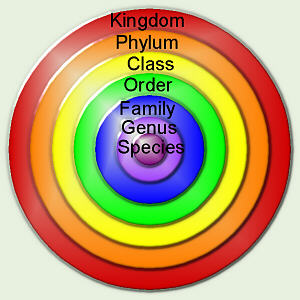
Taxonomic Hierarchy
We humans like to group these species and organize them into categories. The
only category that actually exists in nature is individual species —
everything else is groupings we have invented based on similarities among
the organisms we decided should be members of that group. For example,
Monarch Butterflies are real creatures that actually exist. However if we
speak of all butterflies, this is a grouping we humans have made based on
those organisms having similarly-shapes wings with brightly-colored scales
all over them. We also tend to categorize the categories. For example, we
say that butterflies are part of the insects, and that insects are part of
the animals. Biologists around the world use an official classification
system invented by Linnaeus back in the 1700s. In this system (going from
the top, down rather than bottom, up as in the previous example), all
living organisms are first divided into Kingdoms.
As of a few years ago when this Web page was created,
taxonomists recognized five kingdoms (which, hopefully
you recall from first semester), which are:
K. Monera
(bacterium) |
K. Protista
(alga) |
K. Fungi
(mushroom) |
K. Plantae
(daisy) |
K. Animalia
(chickadee) |
 |
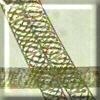 |
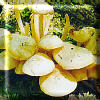 |
 |
 |
Now, Kingdom Monera has been divided into several Kingdoms,
based on differences in the cell structure of the various organisms
involved.
Each kingdom is subdivided into a number of phyla
(singular is phylum). For example,
within Kingdom Animalia, some (there are others) of the phyla are:
P. Mollusca
(snail) |
P. Arthropoda
(butterfly) |
P. Chordata
(toad) |
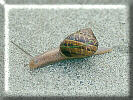 |
 |
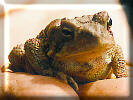 |
Each phylum contains several classes. For example,
Phylum Chordata (Subphylum Vertebrata — yes, we also have sub- and super-
categories!) contains (there are others, here, too):
C. Osteichthyes
(fish) |
C. Amphibia
(frog) |
C. Reptilia
(turtle) |
C. Aves
(bird) |
C. Mammalia
(goat) |
 |
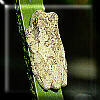 |
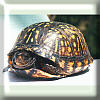 |
 |
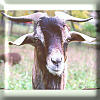 |
Each class contains several orders. For example,
Class Mammalia contains (among others):
O. Marsupialia
(opossum) |
O. Rodentia
(mouse) |
O. Carnivora
(cat) |
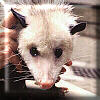 |
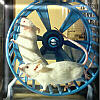 |
 |
O. Artiodactyla
(pig) |
O. Primate
(marmoset) |
O. Proboscidae
(elephant) |
 |
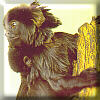 |
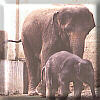 |
Each order contains several families. One of the
families in the Primates is Family Hominidae (gorilla, chimpanzee, orangutan,
and human).
Each family contains several genera (singular is genus), and each
genus contains one or more species. For example, one of the genera
in family Hominidae is Homo. Two species in that genus are
erectus (extinct) and sapiens, which happens to be the only
living species in that genus. This is not the case for all genera: for
example Penicillium notatum is the mold that makes penicillin for us,
Penicillium roqueforti and Penicillium camemberti make
roquefort/blue, and camembert cheeses, respectively. A number of students
have found the mneumonic
“Kings
Play
Chess
On
Fairly
Green
Spaces”
to be of use in remembering the taxonomic hierarchy
(Kingdom,
Phylum,
Class,
Order,
Family,
Genus,
Species).
How to Write Scientific Names:
In biology, each organism’s official name is its genus and its
species names together, for example: Homo sapiens. This system of
two-part scientific names was also invented by Linnaeus. These names
are Latin or Latinized words, thus are a “foreign” language. It is customary,
in any book or publication, to italicize anything that is in a foreign
language (relative to the language in which the publication is written), and
you have, hopefully, seen examples of this in various books you have read.
This means that scientific names should also always be
italicized,
which is easy to do with today’s computers and word processors. However, if
you are writing something on a typewriter or by hand (like on a biology test
— hint, hint!) the proper, official thing to do is to
underline
the scientific name to indicate that it is supposed to be italicized. Also,
note that the first letter of the genus name is always capitalized, and the
first letter of the species name never is, even if it was derived from a
proper noun (Newspapers and magazines are notorius for getting this wrong!
Don’t always trust what you see there). For example, there is a butterfly
named Dryas julia, and even though the scientist named it after his
lady friend, we don’t capitalize her name used as a species. Also, our
local chickadees are know as Parus carolinensis, and note that the
species is still lower case. Thus, the scientific name for humans,
correctly spelled and italicized is
Homo sapiens
(sapiens = wise).
Note also that, yes, the genus and species are two words, and that,
yes, sapiens does, indeed, have an “s” on the end like
“scissors,” “pants,” or “gas.” And, just in case you’re wondering, yup,
you will see this again — on a test.
References:
Anderson, Don L. 1990. Planet Earth. The New Solar System,
3rd Ed. (J. Kelly Beatty and Andrew Chaikin, Eds.). Cambridge
Univ. Press. New York. p. 75.
Borror, Donald J. 1960. Dictionary of Root Words and Combining Forms. Mayfield Publ. Co.
Campbell, Neil A., Lawrence G. Mitchell, Jane B. Reece. 1999. Biology, 5th Ed. Benjamin/Cummings Publ. Co., Inc. Menlo Park, CA. (plus earlier editions)
Campbell, Neil A., Lawrence G. Mitchell, Jane B. Reece. 1999. Biology: Concepts and Connections, 3rd Ed. Benjamin/Cummings Publ. Co., Inc. Menlo Park, CA. (plus earlier editions)
Gardner, Eldon J. 1968. Principles of Genetics,
3rd Ed. John Wiley & Sons, Inc., New York. pp. 409 and
411.
Marchuk, William N. 1992. A Life Science Lexicon. Wm. C. Brown Publishers, Dubuque, IA.
Copyright © 1997 by J. Stein Carter. All rights reserved.
This page has been accessed  times since 15 Mar 2001.
times since 15 Mar 2001.


























